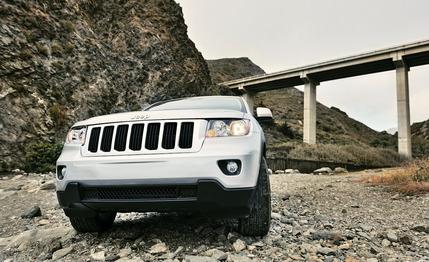
 Road Test
Road Test


A tarantula hawk is not a hawk, but a giant wasp that lives in California’s deserts. An expectant female can be up to four inches long, and when the time comes, she pounces on the nearest tarantula, which is also native to deserts lit orange at night by the glow of Los Angeles. She paralyzes the spider with her half-inch stinger, then drags the prostrate arachnid to an underground lair where she lays a single white egg on it. The egg hatches after five days, and the infant wasp dines on its hapless victim for about a month, craftily saving the organs for last so that the spider remains alive—and fresh.
As luck would have it, we did not encounter any four-inch-long wasps while testing the 2011 Jeep Grand Cherokee, which is fine because a tarantula hawk’s sting rates on the Schmidt Sting Pain Index as feeling “blinding, fierce, shockingly electric, [like a] running hair dryer has been dropped in your bubble bath.”
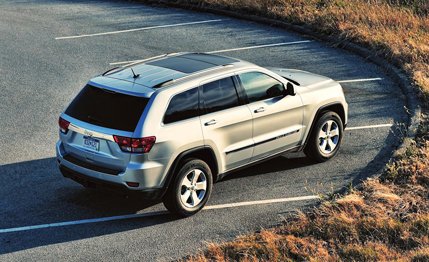

However, while driving our $38,785 Grand Cherokee Laredo 4X4 from San Francisco to Los Angeles, we did explore a few out-of-the-way places where green mountains thrust skyward and condors soar, where the ocean laps sand soft enough to trap wimpier SUVs, and where the pinyon pines and the purple nightshades hide ravenous ticks who like to crawl up a car photographer’s leg while he’s composing a shot.
In other words, places where nobody who spends the same sum of money on a car will ever go.
And that’s the point of buying a Grand Cherokee. To see places and meet bugs you can’t in other vehicles. From the moment former Chrysler exec Bob Lutz drove the very first Grand Cherokee through a plate-glass window at the 1992 Detroit auto show—folks still talk about it—the GC (as compared with the iconic Wrangler) has amounted to five seats in an up-trimmed wagon that is equally ready for the mall or an off-road maelstrom.
However, Jeep’s product planners admitted to us at the San Francisco introduction that no more than five percent of owners ever leave pavement. That fact has been discussed and debated over the years by the company’s various overlords. The 2011 Grand Cherokee started development five years ago at DaimlerChrysler, continued during Cerberus ownership, and was finished under Fiat management. We’re told that various suits along the line mentioned that if all Grand Cherokees weren’t overbuilt to survive the Rubicon Trail, they would tally fewer pounds than the hefty 4772 our lightly optioned V-6 Laredo weighed and, thus, return something better than the 19 mpg average we observed.
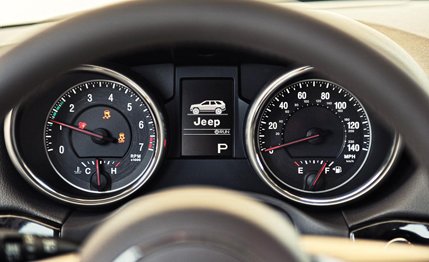

“But then, what would make it special?” asks vehicle line executive Matt Liddane, rhetorically and undoubtedly for something like the 423rd time, as we run our mitts over the GC’s curvaceous new dashboard. Liddane has worked on Jeeps since well before Lutz did the big crash-through, and he believes firmly in preserving the brand’s off-road exceptionalism.
While Liddane is talking about test runs to Jeeper hangouts like Moab, Utah—the location of our first experience with the new Jeep Grand Cherokee—we can’t help but notice that the new GC’s dash has a nearly seamless skin, attractive hooded saucers for gauges, and comely, chrome-accented air vents. The interior is made largely of soft-touch materials, and the various pieces interlock with precision. The switches and column stalks move with heft and make soft landings.
Trip and fuel-economy data flow from high-resolution screens between the gauges and on the console, where a multicolor radio display serves as a place keeper for the optional Garmin navigation system, which our working-class Laredo lacked. In back, the rear seat reclines luxuriantly and offers four more inches of legroom than last year’s model, although there’s still no third row.
Besides having an interior that utterly embarrasses past Chrysler products, the ’11 GC shares a very carlike platform with the new Mercedes-Benz ML, due this fall. When we say “carlike,” we’re referring to the cast aluminum lower-control arms up front, the multilink rear suspension, the large disc brakes at all four corners, and the generally refined calibration of the rack-and-pinion steering and the plush ride.
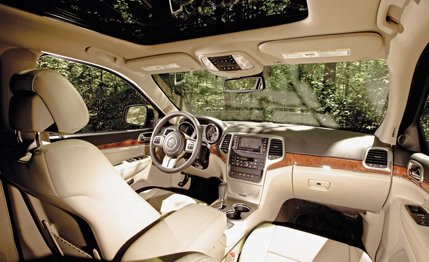

Extensive sound insulation, including triple-layer door seals, laminated glass, and an extra wall in the engine compartment that seals it off from the cabin, convinced us on the freeway dash out of San Francisco that this GC comes closest to being the ruggedly chic and competently multipurpose American pseudo Range Rover that it has always aspired to be. A couple of issues ago, Thomas Steinbeck, son of the late Nobel Prize–winning author John Steinbeck, referred to the Bixby Creek Bridge on Highway 1, so we went there first. The 700-foot span overlooking the Pacific is named after Charles Bixby, an early settler who was also a cousin of President James K. Polk, though more people know the bridge from its cameo in The Graduate. A 10-mile trail winds its way up into the mountains from the bridge. We looked for but did not find any wild javelinas or any terrain to sweat the Grand Cherokee’s capabilities.
The GC’s options list includes a leather-wrapped dashboard and steering wheel, genuine wood, height-adjusting air springs (available as a package on the Laredo, the Limited, and the super-deluxe Overland), and three versions of four-wheel drive. Prices can reach the mid-40s on the flagship Overland with the Hemi V-8.
Our mid-level, four-wheel-drive Laredo X—there’s also a thriftier Laredo E, starting at $30,995 with rear drive—had the simplest of the four-wheel drivetrains: Quadra-Trac I, permanently engaged four-wheel drive with a fixed 50/50 torque split and brake-based traction control governing its open differentials. The fancier systems add electronic limited-slip couplings to the center and rear differentials, plus a control that tailors the torque bias and the throttle response to various terrain.
The 3.6-liter “Pentastar” V-6 is all-new and checks most of the current technology boxes: aluminum construction, 24 valves, roller rockers, and phasing on all four cams. Space on the heads has been saved for direct injection, should it be deemed worthwhile in the future. With a five-speed automatic transmission behind it, the engine is a smooth motivator to 60 mph, yours in 8.4 seconds with a spirited exhaust snarl to accompany it.
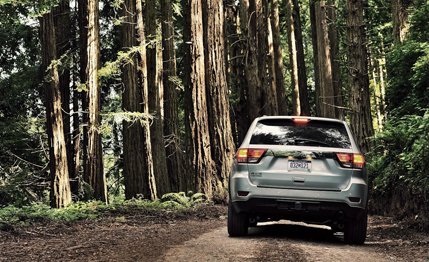

If a second or two worth of haste is needed, there’s always the 5.7-liter Hemi V-8, with another 2200 to 2400 pounds of tow capacity beyond the V-6’s 5000 but city fuel economy in the low teens. Only about 40 percent of buyers are expected to take the V-8. We wouldn’t, not when the V-6 is now so good.
Without a rear-drive-only mode, our Laredo’s all-wheel drivetrain undoubtedly bit into fuel economy, but it ran quietly at expressway speeds and with no obvious drag on the V-6’s 290 horsepower. And it supplied solid traction on the Oceano Dunes State Vehicular Recreation Area near Pismo Beach, where anyone can pay five dollars to drive on the well-tracked sand.
Pismo takes its name from the Chumash Indian word pismu, or tar. In various places along California’s coast, pismu seeps up from the underworld naturally. The ranger looked us up and down with a seen-your-type-before glare and warned us repeatedly not to drive on the actual dunes or into the ocean. Apparently, this is a big problem, especially on weekends. It was Tuesday, and in addition to a thoroughly stuck Ford Edge, we also spotted a Knight Rider–era Trans Am, sunk to its doorsills roughly 37 feet beyond the paved entrance.
Eventually we wheeled into L.A.—it’s easily a one-tank trip with 24.6 gallons aboard—feeling fresh in the GC’s comfortable buckets, though the floor mats were doused with sand and the lovely dash was blemished with the crushed bodies of numerous ticks. If no tarantula hawks were to be observed, at least we witnessed America’s most perennially troubled automaker make a convincing case that it’s turning things around. Perhaps, this time, for good.